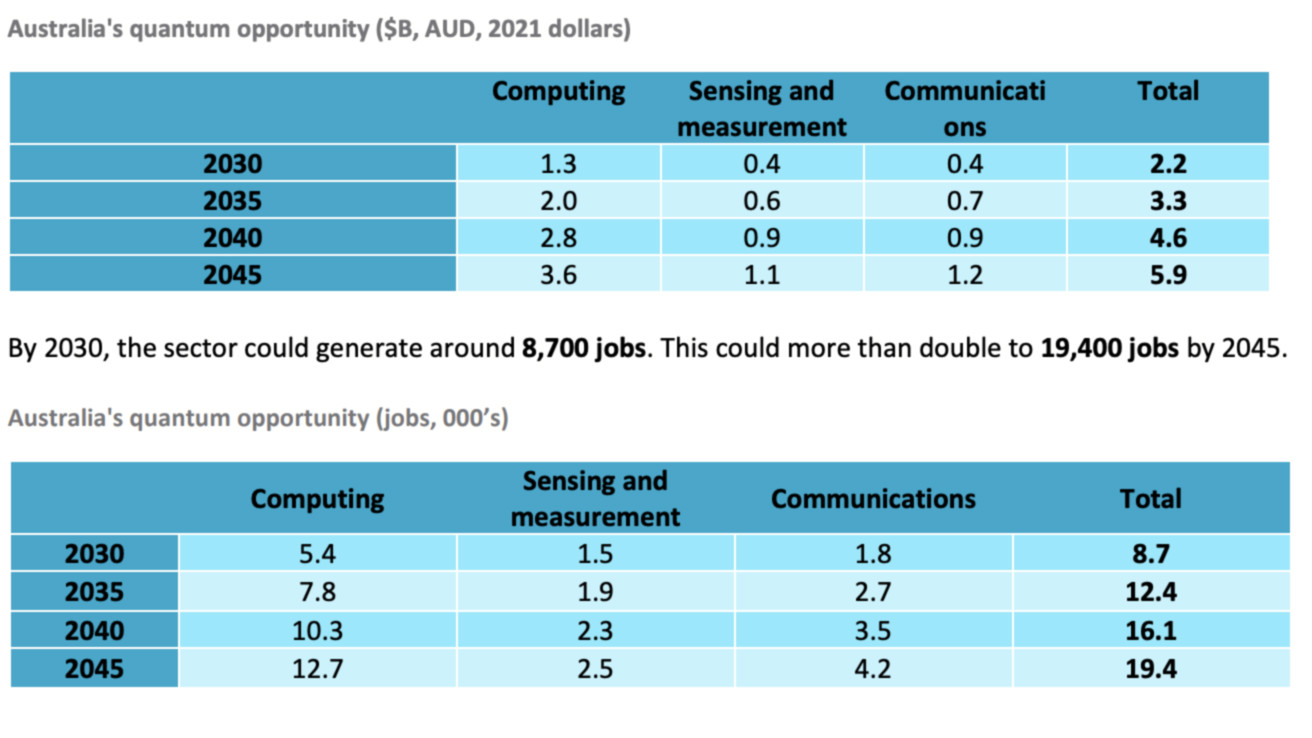How Australia is at the forefront of multi-billion dollar quantum computing revolution

The race is on to build the first error-corrected quantum computer. Pic: Getty Images
- The National Quantum Strategy aims to ensure Australia is at the forefront of quantum computing
- Australia’s quantum tech opportunity could reach $2.2 billion by 2030 & $6 billion by 2045
- Archer Materials remains the only quantum computing stock on the ASX but others unlisted
The race is on at a global scale to build the first error-corrected quantum computer.
Not to be left behind, the Federal Government has released the new National Quantum Strategy to ensure Australia is well placed out of the starting blocks.
The strategy consists of five themes to realise the Government’s ambition of ensuring Australia is a leader in the field of quantum computing including:
- Thriving research and development, investment in and use of quantum technologies
- Securing access to essential quantum infrastructure and materials
- A skilled and growing quantum workforce
- Standard and framework that support national interest
- A trusted ethical and inclusive quantum ecosystem
There’s no doubt digital computing, first traced back to the 1940s, has had a profound impact on the world. Advancements in digital computers have revolutionised the way we work, communicate, and live our lives.
Now quantum computing, a fundamentally different approach to computing that relies on the principles of quantum mechanics, is forecast to bring significant changes to the world.
Author of the book Quantum Supremacy and co-founder of string field theory, futurist and physics professor at the City University of New York Michio Kaku describes quantum computing as “humanity’s next great technological achievement”.
Kaku believes quantum computing may eventually illuminate the deepest mysteries of science and solve some of humanity’s biggest problems including global warming, world hunger, and incurable disease.
What is quantum computing?
First, a disclaimer. Obviously quantum mechanics is complicated, so consider any explanations of such as very much told in layman’s terms. But that doesn’t make it any less fascinating, and it’s still very clear that computing is about to change in a major way.
CSIRO’s Quantum Future Science Platform Director Dr Scott Martin describes well the field of quantum mechanics.
“Quantum mechanics is a discipline of physics that describes the behaviour of matter and energy at the smallest scale, such as electrons, photons, and atoms that make up our physical world,” he said.
“Understanding quantum mechanics has led to the concept of quantum computing that promises to revolutionise computing power and solve some of the world’s most complex problems.”
Unlike classical digital computers, which use bits to represent data with a value of either 0 or 1, quantum computers use qubits that can exist in a superposition of both states simultaneously.
As a result, ground-breaking quantum computing technology can perform certain calculations exponentially faster than classical computers, opening new possibilities for many fields including cryptography (think enhanced security), drug discovery and artificial intelligence (AI).
Overcoming errors
Remember at the start of this article how we said the race is on to build the first error-corrected quantum computer? The key term in that sentence was ‘error-corrected’.
Despite enormous potential, quantum computing is still a nascent technology facing significant challenges.
Quantum computers are highly sensitive to errors caused by decoherence, which is the loss of information due to interactions with the environment.
To address the issue, error-corrected quantum computing uses specialised algorithms and hardware to detect and correct errors in qubits.
By encoding qubits in such a way that errors can be detected and corrected, error-corrected quantum computing aims to create a reliable, fault-tolerant quantum computer that can perform complex calculations with minimal errors.
But it’s not so simple. Implementing error correction in quantum computing is a complex problem requiring a combination of theoretical and experimental research.
Nevertheless, progress is being made in the area.
From evolutionary to revolutionary
While there are still many technical and practical challenges that need to be overcome before quantum computing becomes a part of our everyday life, Dr Martin, like many in the field, believes the technology will have many valuable uses ranging from evolutionary to revolutionary.
“For example, quantum sensors have been used for many years for ultra-sensitive detection in mineral exploration and medical scanning – and there are many teams around the world working on the next generations of such technologies,” he said.
Dr Martin said quantum computers have the potential to solve problems that are currently impossible for classical computers to solve.
“This could lead to major breakthroughs in fields like drug discovery, materials science, and cryptography,” he said.
“Quantum communication is already being used to create unhackable networks, and it has the potential to revolutionise internet security.
“Quantum communication also has potential applications in secure voting systems, financial transactions, and military communications.”
He said quantum sensors have the potential to revolutionise industries such as medical imaging and environmental monitoring.
“Quantum sensors could allow doctors to detect cancerous tumours earlier and with greater accuracy than current technologies,” he said.
“Quantum dots could be used to create more efficient solar panels, while quantum batteries could store energy more efficiently than current batteries.”
Dr Martin said quantum technology could revolutionise transportation by making it possible to create more efficient and powerful propulsion systems, as well as to optimise large, complex transport networks in near real time.
Australia has a competitive advantage in quantum?
While it is hard to find exact figures (they vary enormously), as a technology set to revolutionise the way we live quantum computing is fast becoming BIG business.
Precedence Research said the global quantum computing market size is expected to surpass US$125 billion by 2030, poised to grow at a projected CAGR of 36.89% during the forecast period of 2022 to 2030.
And with big money, sheer advantages and power expected to come from the technology, the quest to develop the world’s first error-corrected quantum computer has transformed into a global phenomenon akin to the spirited competition of the Olympic Games.
Countries worldwide are fervently vying to emerge victorious including the usual players we would expect such as China, the US and Russia but also Germany, France, Japan and Canada are making progress.
And then there is Australia. According to Dr Martin, Australia has been a leader in quantum technology research and development for almost 30 years – and has produced more than 2,500 PhDs in that time.
“Across the nation there are world-leading teams in silicon quantum computers, quantum communications, machine learning, algorithms and quantum devices, to name a few,” Dr Martin said.
“Australia has the capability to translate these scientific advantages into commercial products and services – and to do so in Australia.”
He said the National Quantum Strategy calls for a sustained effort from all stakeholders across Australia to build a vibrant and globally significant industry in quantum technologies.
“The strategy reiterates the need to build our quantum workforce and infrastructure capability while supporting and collaborating with local and international partners.”
According to a CSIRO report by 2030, Australia’s quantum technology opportunity could reach $2.2 billion and generate 8,700 jobs. By 2045, Australia’s quantum technology opportunity could almost reach nearly $6 billion and 19,400 jobs.

New high growth industry for Australia
CSIRO’s executive director for Digital National Facilities & Collections Professor Elanor Huntington said the global quantum industry is maturing rapidly as nations invest in technology advancement.
“We are now at an inflection point with a wave of quantum technological disruption on the horizon,” she said.
“Without quantum physics, there would be no internet, computers, or magnetic resonance imaging.
“Now, scientists and engineers can unlock unprecedented capabilities to isolate, control and sense individual quantum particles – such as electrons and photons – like never before.”
Prof Huntington said commercialising these technologies will create a new high growth industry with the potential to create economic growth and jobs across a range of sectors.
“Australia has world class quantum technology research and development capabilities, and we are well placed to be a global leader in the field,” she said.
“The National Quantum Strategy is a call to action for Australia to act now to capitalise on this potentially paradigm-shifting wave of technology.”
One lonely quantam player on ASX
Among the big players of companies in the qantum computing race are Google, IBM, Microsoft and Amazon Braket.
Presently, the ASX’s only quantum computing stock is Archer Materials (ASX:AXE), however, there are other players unlisted and this could change in the future.
AXE is focused on progressing its 12CQ quantum computing qubit process chip (12CQ chip) and its ‘lab-on-a-chip’ biochip.
AXE’s 12CQ chip is being developed to enable mobile quantum computing devices.
The 12CQ chip can be integrated with current technologies as it uses standard and commercially available metal-oxide-semiconductor (CMOS) chip technology for detecting quantum information at room temperature.
The semiconductor industry predominantly employs CMOS technology for chip design, which is widely used for creating integrated circuits in various applications.
In its recent Q3 FY23 update AXE executive chairman Greg English announced the company had “successfully developed a fabrication process for the manufacture of wafer-based functional devices (chips) for its quantum electronic devices”.
“The company used industry standard semiconductor nano fabrication to facilitate the fabrication of potentially hundreds of advanced quantum electronic devices on a single silicon wafer,” he said.
AXE also achieved a scientific milestone during the quarter announcing it had overcome a conventional limitation of graphene field effect transistors (gFET) sensing that paves the way to the selective detection of target molecules.
The AXE share price today:
Related Topics
UNLOCK INSIGHTS
Discover the untold stories of emerging ASX stocks.
Daily news and expert analysis, it's free to subscribe.
By proceeding, you confirm you understand that we handle personal information in accordance with our Privacy Policy.







